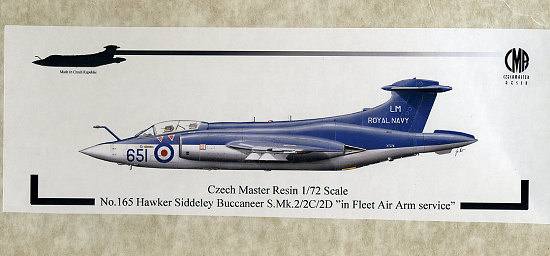
| KIT: | CMR 1/72 Buccaneer S Mk 2/2C/2D |
| KIT #: | 165 |
| PRICE: | $ |
| DECALS: | 12 options! |
| REVIEWER: | Scott Van Aken |
| NOTES: | Resin multi-media kit |

| HISTORY |
The Buccaneer was designed to fulfil Naval Staff Requirement NA39 (Ministry of Supply Specification M.148T) issued in 1953 for a carrier-borne strike aircraft with a long range (430 nautical mile radius of action), capable of 610 knots at sea level, carrying an internal load of up to 4,000 pounds (including nuclear weapons) - below enemy radar - and attacking ships or ports. Blackburn's design by B. P. Laight, B-103, won the tender. Due to secrecy, the aircraft was called BNA (Blackburn Naval Aircraft) or BANA (Blackburn Advanced Naval Aircraft) in documents leading to the obvious nickname of "Banana Jet".
The Buccaneer was a mid-winged, twin-engined monoplane with a crew of two seated in tandem under a sliding canopy. In order to meet the demands of the specification the Buccaneer featured a number of novel and advanced design features. The fuselage was area ruled; meaning it was designed to reduce drag at transonic speeds. This gives rise to the characteristic curvy "Coke bottle" shape.
The small wing of the Buccaneer is suited to high-speed flight at low level. Such a wing, however, does not generate the lift that is essential for low-speed carrier operations. Therefore, the wing and horizontal stabiliser are "blown" by bleeding compressor gas from the engine through surface vents. A consequence of the blown wing is that the engines are required to be run at high power for low-speed flight (in order to generate sufficient compressor gas for blowing). Blackburn's solution to this seemingly counter-productive situation was to provide a large air brake. The tail cone was formed from two leaves that could be hydraulically opened into the airstream to decelerate the aircraft. The nose cone and radar antennae could also be swung around by 180 degrees to reduce the length of the aircraft in the carrier hangar. This feature was particularly important as contemporary British aircraft carriers were particularly small.
The Buccaneer featured a variable incidence tailplane that could be trimmed to suit the particular requirements of low-speed handling or high-speed flight. At the low-levels and high speeds that the Buccaneer had to operate bomb bay doors could not be opened safely into the air stream, therefore ingenious doors were developed that rotated into the fuselage to expose the payload. This was also useful in assisting ground-level access.
The first Buccaneer model, the S Mk.1, was powered by a pair of de Havilland Gyron Junior turbojets producing 7,100 pounds of thrust. This mark was somewhat underpowered, and as a consequence could not take off fully laden with both fuel and armament. A temporary solution to this problem was the "buddy" system; aircraft took off with a full load of weaponry and minimal fuel and would sortie with a Supermarine Scimitar that would deliver the full load of fuel by aerial refuelling. This was not an ideal solution however, as the loss of an engine during take-off could have been catastrophic, and the Gyron Junior gave a poor range due to high fuel consumption. The long term solution was the S Mk.2, fitted with the Rolls-Royce Spey turbofan, providing 40% more thrust with a greatly reduced fuel consumption. The engine nacelles had to be enlarged to accommodate the Spey, and the wing required minor aerodynamic modifications as a result. The Mark 2 Buccaneer had completely replaced the Mark 1 by November 1966.
With the introduction of the Martel air-to-surface missile, Some Mark 2 aircraft were converted to carry it, and became S Mk.2D. The remaining aircraft became S Mk.2C. Sixteen aircraft were built (and fifteen delivered) for the South African Air Force as the S Mk.50, Mark 2 aircraft with the addition of Bristol Siddeley BS.605 rocket motors to provide additional thrust for the "hot and high" African airfields.
When the Fleet Air Arm's fixed-wing operations ended in 1978, 62 of the 84 Buccaneer Mark 2 aircraft were transferred to the Royal Air Force (RAF) as S Mk.2A. These joined 26 aircraft that had been built by Blackburn's successor, Hawker Siddeley for the RAF as the S Mk.2B. These aircraft were not navalised and, like the Mk.2A, had RAF-type communications and avionics equipment. The type was withdrawn from RAF service in the late 1990s and from SAAF use a few years later.
| THE KIT |
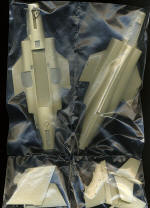 I have seen a lot of kits in my many years i
I have seen a lot of kits in my many years i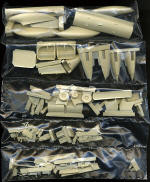 n this hobby, but this one has to be the most complete and most detailed 1/72 offering of its kind I've ever laid eyes on. Describing it brings out a flood of superlatives. Outstanding detail work that we've come to expect from CMR and every conceivable option that was ever applied to a Buccaneer. There is no need to go outside this kit for bits as it is all right here.
n this hobby, but this one has to be the most complete and most detailed 1/72 offering of its kind I've ever laid eyes on. Describing it brings out a flood of superlatives. Outstanding detail work that we've come to expect from CMR and every conceivable option that was ever applied to a Buccaneer. There is no need to go outside this kit for bits as it is all right here.
It is difficult to know where to start so I'll just begin with the instruction sheet. Actually, it is more than just instructions, it is a reference in and of itself. There are seven pages of well drawn construction steps. Each section shows the optional bits and refers them to a specific variant and even a certain decal scheme or schemes. This is followed by 12 pages of color and marking schemes. But these schemes are more than just what to paint it and where to put the decals. It also shows what optional weapons the aircraft can handle.
There are then four pages of stencil data, including what goes on what weapons. This is also determined by the variant being build. A three page load-out information diagram is then provided and this is also keyed to th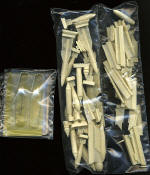 e specific markings scheme and the mission. The next three pages are a painting guide for the little bits and is keyed to part number. Again, it is cross referenced to the markings scheme that will be used and includes weapons colors. Finally, there are six pages of black and white photos, showing not only the aircraft on the sheet, but also close-up images of various bits of the aircraft. As I said, more of a reference than a set of instructions.
e specific markings scheme and the mission. The next three pages are a painting guide for the little bits and is keyed to part number. Again, it is cross referenced to the markings scheme that will be used and includes weapons colors. Finally, there are six pages of black and white photos, showing not only the aircraft on the sheet, but also close-up images of various bits of the aircraft. As I said, more of a reference than a set of instructions.
So how about the options? Well, you have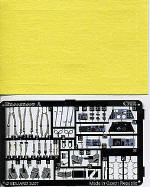 two sets of seats (one with the harnesses molded on and the other for use with the p.e.). The option of exposed hold-backs for the bridle, optional bomb bays, optional wing fold, optional wing ECM antenna, optional tail planes, optional speed brake designs as well as optional open or closed brakes. You can also fold the nose cone, have the tail bumper raised or lowered, have the tail hook up or down, and a huge arrangement of weapons, fuel tanks and pylons. The kit also provided two sets of vacuformed canopies and the blast shield for the g.i.b. You'll excuse me for not spilling out what has to be well over a hundred pieces
two sets of seats (one with the harnesses molded on and the other for use with the p.e.). The option of exposed hold-backs for the bridle, optional bomb bays, optional wing fold, optional wing ECM antenna, optional tail planes, optional speed brake designs as well as optional open or closed brakes. You can also fold the nose cone, have the tail bumper raised or lowered, have the tail hook up or down, and a huge arrangement of weapons, fuel tanks and pylons. The kit also provided two sets of vacuformed canopies and the blast shield for the g.i.b. You'll excuse me for not spilling out what has to be well over a hundred pieces so they can be photographed. I think that just showing them in their bags will give you a very good idea of how complete this kit really is.
so they can be photographed. I think that just showing them in their bags will give you a very good idea of how complete this kit really is.
The photo etch fret is in color and by Eduard, as are the canopy and wheel masks. There are two full sheets of decals with serials, data markings and unit codes. The sheet is superbly printed and will prove to be quite thin. I'd rattle off the units that are on it, but it seems to me that there is an option for every FAA unit and markings variant that flew the Mk. 2/2C/2D version of the Buccaneer.
| CONCLUSIONS |
If you buy only one 1/72 Buccaneer kit in your life....no.... make that ANY Buccaneer kit, then this is it. You can consign your Matchbox and Airfix kits to the spares bin or give them away. This one is the only one you'll need. Those of you who have to have an RAF Buccaneer, will appreciate that there is a similar kit offered for the S.2B, and probably one will arrive for the S.50 as used by the SAAF.
April 2007
My thanks to  Czech Master Resin for providing the review copy.
Czech Master Resin for providing the review copy.
If you would like your product reviewed fairly and fairly quickly by asite that has over 350,000 visitors a month, please contactme or see other details in the